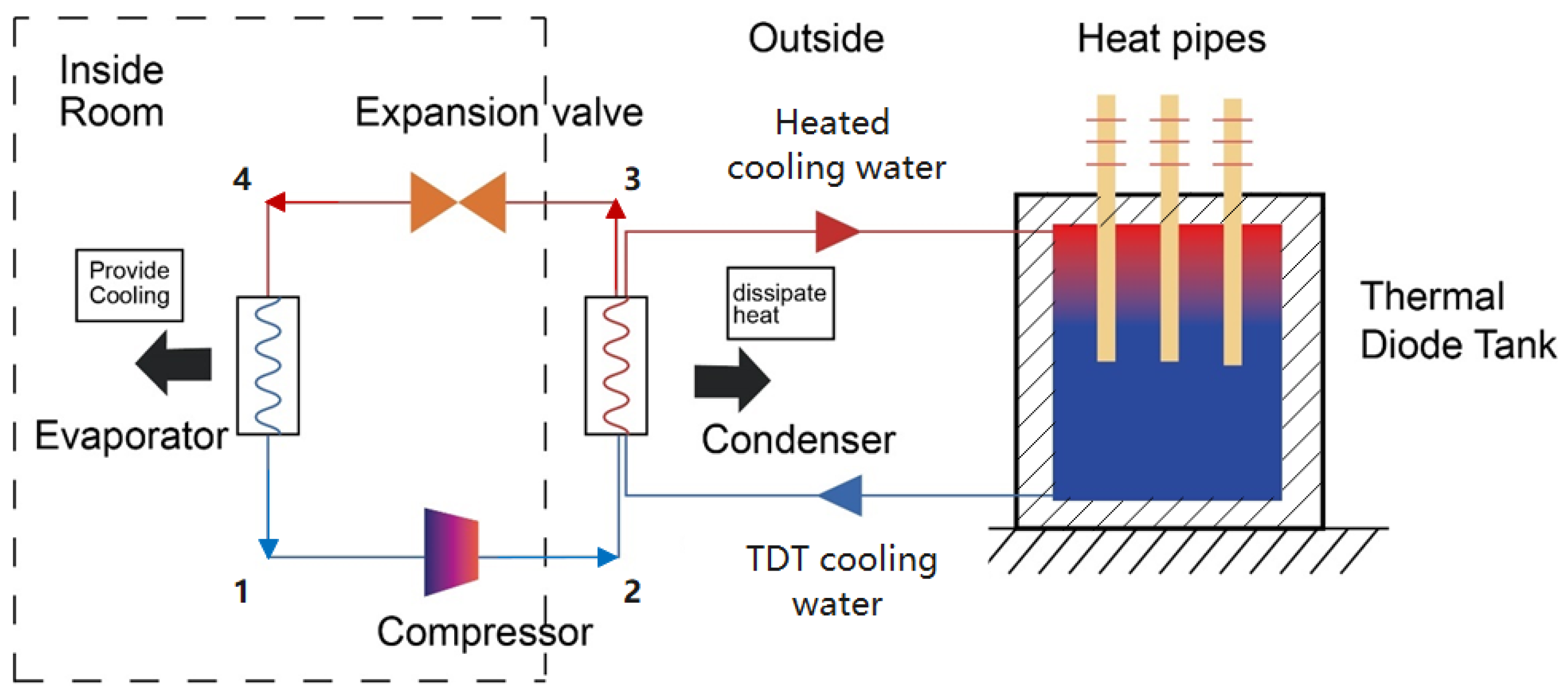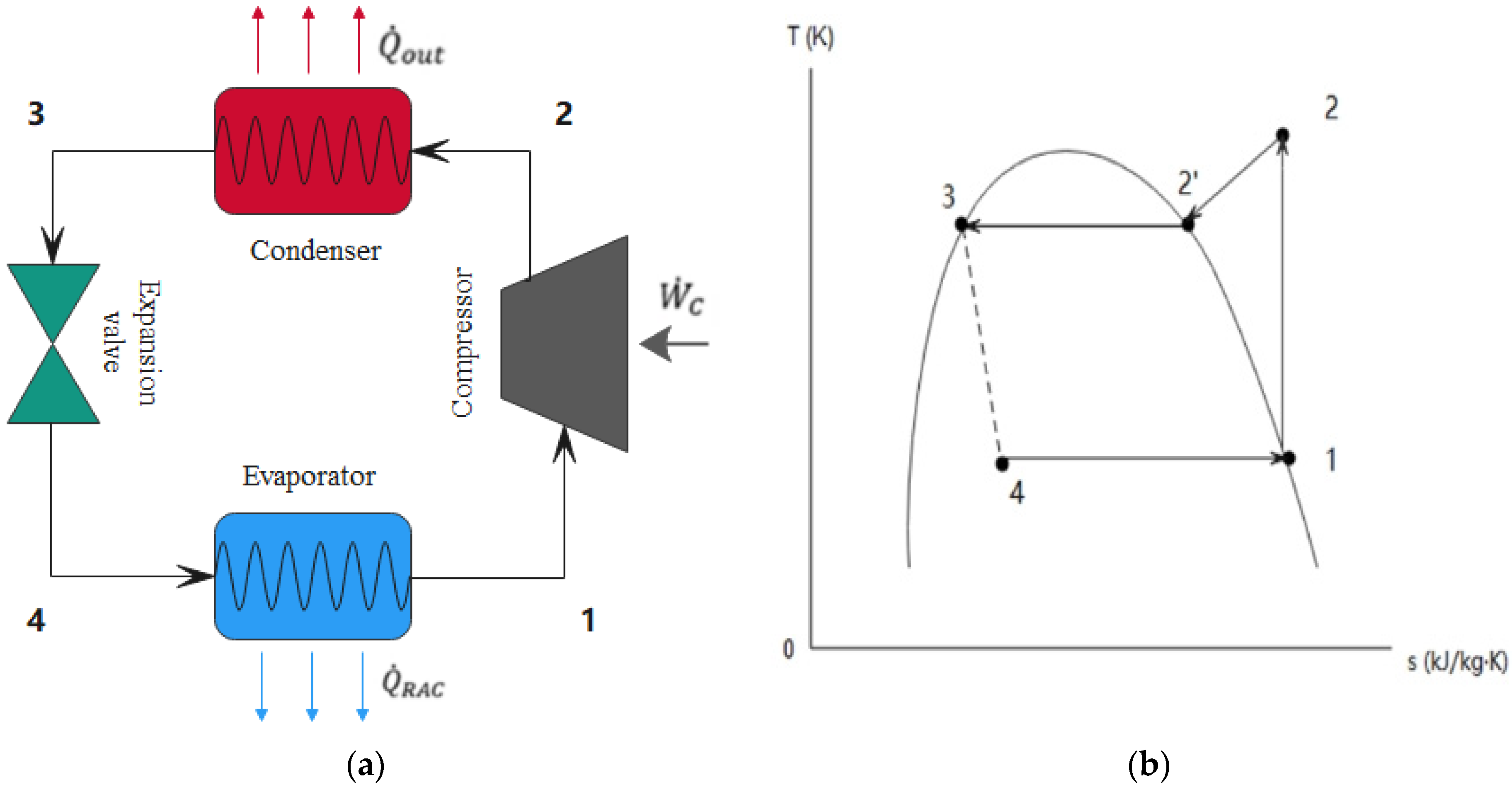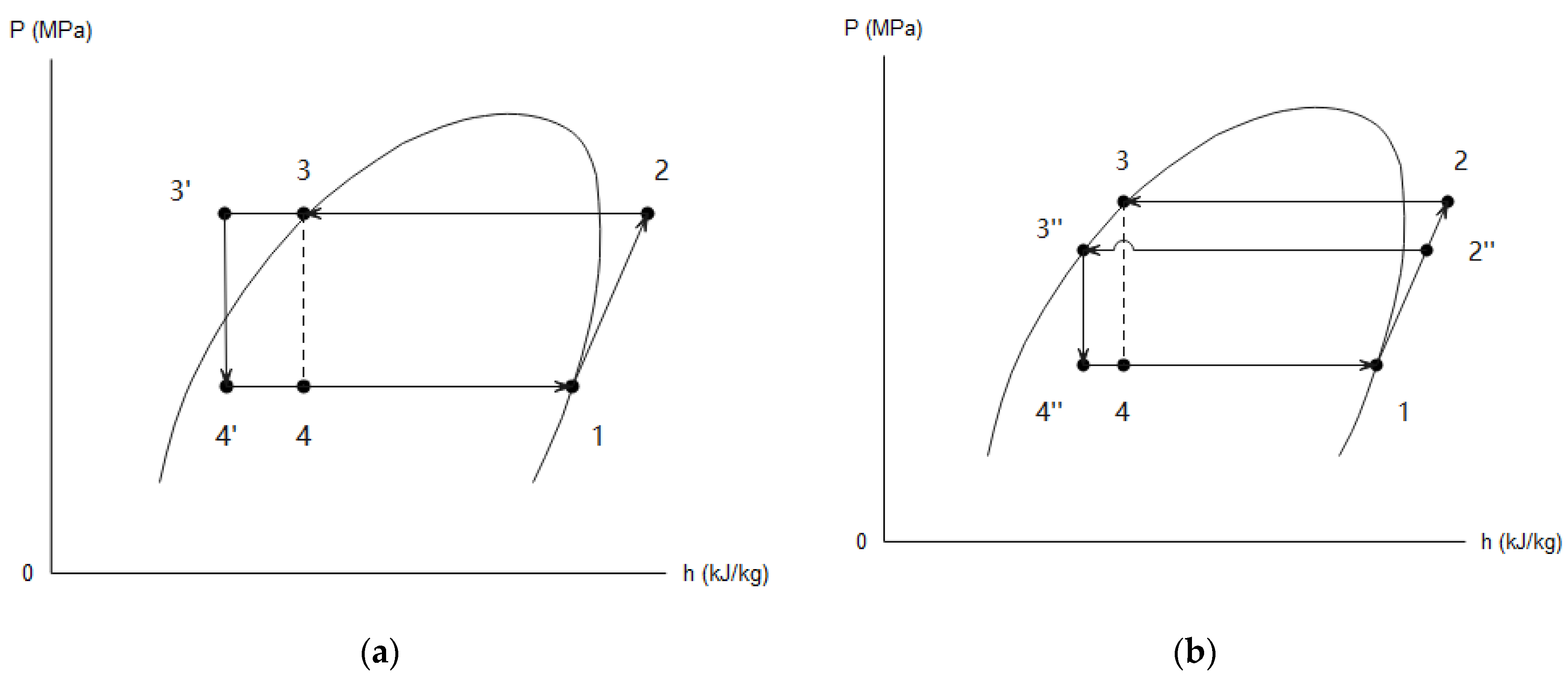Energy-Saving Potential of Thermal Diode Tank Assisted Refrigeration and Air-Conditioning Systems
Abstract
1. Introduction
2. Thermal Diode Tank (TDT)
3. Modelling of TDT-RAC Cycles
3.1. Baseline Cycle
3.2. TDT-RAC Cycles
3.3. Mathematical Model
- The TDT is well insulated and has heat transfer with surroundings only through heat pipes;
- The temperature of water inside TDT is uniform at any times;
- The process from 1 to 2 in the RAC system compressor is isentropic;
- The heat released by the RAC system’s condenser is completely absorbed by the TDT water;
- There is no energy loss in the expansion valve, so h3 = h4, h3′ = h4′ and h3″ = h4″;
- The convection heat transfer coefficient of water is higher than that of air, so the condensing temperature is 10 °C over the day time ambient temperature for the baseline cycle, and 5 °C over the TDT water temperature for the TDT-RAC cycles;
- The evaporating temperature is 10 °C lower than the room temperature set;
- There is sufficient heat transfer capacity of heat pipes installed with the TDT, so the TDT water temperature in the early morning is assumed to be 3 °C higher than the minimum ambient temperature of last night.
3.3.1. Cycle 1: A Baseline Cycle
3.3.2. Cycle 2: A TDT-RAC Cycle with a Fixed Speed Compressor
3.3.3. Cycle 3. A TDT-RAC Cycle with a Variable Speed Compressor
4. Energy-Saving of TDT-RAC Systems
4.1. Energy-Saving Indicator
4.2. The Reference Case
5. Sensitivity Analysis
- Day time and night ambient temperatures;
- Tank size;
- RAC system cooling capacity;
- Coupled effect of tank size and cooling capacity.
5.1. Day and Night Ambient Temperatures
5.2. Tank Size/Water Volume
5.3. RAC System Cooling Capacity
5.4. Coupled Effect of Tank Size and Cooling Capacity
6. Case Study
7. Conclusions
- The Thermal Diode Tank (TDT) is proved that it can theoretically reduce the energy consumption of the RAC system if they are properly equipped;
- An increasing day/night ambient temperature difference can improve the energy-saving percentages of TDT-RAC cycles;
- There is a threshold tank size existing for a given TDT-RAC cycle to save energy. If the tank size was below the threshold value, the TDT-RAC cycle would not save energy. Increasing the tank sizes above the threshold can increase the energy-saving percentages;
- With the tank size above the threshold while other parameters remain the same, the TDT-RAC cycle with a variable speed compressor always achieves a higher energy-saving percentage compared to that with a fixed speed compressor;
- The threshold and optimum value for the “Tank Size on Cooling Capacity (TS/CC)” in Figure 11 are found as 0.174 m3/kW and 1 m3/kW, respectively, under the conditions of this study. For future experiment, the range of tank size can be determined based on these two values with a given cooling capacity.
- The case study shows that, compared with the baseline cycle, the TDT-RAC cycle with a fixed speed compressor could, on average, save 2.4~18.1% energy, while the TDT-RAC cycle with a variable speed compressor could save 14.9~61.4% energy. Over the whole month, 9.1~40.4% energy can be saved by TDT-RAC cycles every day on average.
8. Patents
Author Contributions
Funding
Institutional Review Board Statement
Informed Consent Statement
Data Availability Statement
Acknowledgments
Conflicts of Interest
Nomenclature
| Specific heat capacity (kJ/kg °C) | |
| Saved energy (kJ) | |
| h | Specific enthalpy (kJ/kg) |
| Mass flow rate (kg/s) | |
| Heat through to condenser(kJ) | |
| The rate of heat through to condenser (kW) | |
| Cooling energy (kJ) | |
| Cooling capacity (kW) | |
| Day time ambient temperature (°C) | |
| Night time ambient temperature (°C) | |
| Room temperature (°C) | |
| Water temperature (°C) | |
| ∆Tdaily | Daily day and night ambient temperature difference (°C) |
| Refrigeration and air-conditioning system daily operating time (h or s) | |
| Refrigeration and air-conditioning system operating time interval (h or s) | |
| Tank size (m3) | |
| Input power by compressor (kW) | |
| Input energy by compressor (kJ) | |
| Greek Symbols | |
| Density (kg/m3) | |
| Abbreviations | |
| CHP | Convective Heat Pipe |
| COP | Coefficient of Performance |
| EER | Energy Efficiency Ratio |
| ESP | Energy-Saving Percentage |
| GHP | Gravity Heat Pipe |
| GSHP | Ground-source Heat Pump |
| HVAC | Heating, Ventilation, and Air-conditioning |
| RAC | Refrigeration and Air-conditioning |
| TDT | Thermal Diode Tank |
| TDT-RAC | Thermal Diode Tank-assisted Refrigeration and Air-conditioning |
References
- Sugarman, S.C. HVAC Fundamentals; River Publishers: Gistrup, Denmark, 2020; p. 509. [Google Scholar]
- Department of Climate Change and Energy Efficiency (DCCEE). Australia’s Emissions Projections, 2012; DCCEE: Canberra, Australia, 2012.
- Department of Industry, Science, Energy and Resources (DISER). Energy Update: Australian Energy Consumption and Production; DISER: Canberra, Australia, 2020.
- State of the Climate 2020: Bureau of Meteorology. Available online: http://www.bom.gov.au/state-of-the-climate/ (accessed on 23 September 2021).
- Head, L.; Adams, M.; McGregor, H.V.; Toole, S. Climate change and Australia. Wiley Interdiscip. Rev. Clim. Chang. 2014, 5, 175–197. [Google Scholar] [CrossRef]
- Walsh, J.A. Obesity & the First Law of Thermodynamics. Am. Biol. Teach. 2013, 75, 413–415. [Google Scholar] [CrossRef]
- Kumbhar, A.; Gulhane, N.; Pandure, S. Effect of Various Parameters on Working Condition of Chiller. Energy Procedia 2017, 109, 479–486. [Google Scholar] [CrossRef]
- Qiao, Z.; Long, T.; Li, W.; Zeng, L.; Li, Y.; Lu, J.; Cheng, Y.; Xie, L.; Yang, L. Performance assessment of ground-source heat pumps (GSHPs) in the Southwestern and Northwestern China: In situ measurement. Renew. Energy 2020, 153, 214–227. [Google Scholar] [CrossRef]
- Girard, A.; Gago, E.J.; Muneer, T.; Caceres, G. Higher ground source heat pump COP in a residential building through the use of solar thermal collectors. Renew. Energy 2015, 80, 26–39. [Google Scholar] [CrossRef]
- Christodoulides, P.; Aresti, L.; Florides, G. Air-conditioning of a typical house in moderate climates with Ground Source Heat Pumps and cost comparison with Air Source Heat Pumps. Appl. Therm. Eng. 2019, 158, 113772. [Google Scholar] [CrossRef]
- HZhang You, S.; Yang, H.; Niu, J. Enhanced performance of air-cooled chillers using evaporative cooling. Build. Serv. Eng. Res. Technol. 2016, 21, 213–217. [Google Scholar] [CrossRef]
- Wang, T.; Sheng, C.; Nnanna, A.A. Experimental investigation of air conditioning system using evaporative cooling condenser. Energy Build. 2014, 81, 435–443. [Google Scholar] [CrossRef]
- Yu, F.W.; Chan, K.T. Application of Direct Evaporative Coolers for Improving the Energy Efficiency of Air-Cooled Chillers. J. Sol. Energy Eng. 2005, 127, 430–433. [Google Scholar] [CrossRef]
- Waly, M.; Chakroun, W.; Al-Mutawa, N.K.; Al-Mutawa, N.K. Effect of pre-cooling of inlet air to condensers of air-conditioning units. Int. J. Energy Res. 2005, 29, 781–794. [Google Scholar] [CrossRef]
- Chen, X.; Chen, Y.; Deng, L.; Mo, S.; Zhang, H. Experimental verification of a condenser with liquid–vapor separation in an air conditioning system. Appl. Therm. Eng. 2013, 51, 48–54. [Google Scholar] [CrossRef]
- Zhong, T.; Ding, L.; Chen, S.; Chen, Y.; Yang, Q.; Luo, Y. Effect of a double-row liquid–vapor separation condenser on an air-conditioning unit performance. Appl. Therm. Eng. 2018, 142, 476–482. [Google Scholar] [CrossRef]
- Yang, J.; Chan, K.; Wu, X.; Yu, F.; Yang, X. An analysis on the energy efficiency of air-cooled chillers with water mist system. Energy Build. 2012, 55, 273–284. [Google Scholar] [CrossRef]
- Sözen, A.; Filiz, Ç.; Aytaç, I.; Martin, K.; Ali, H.M.; Boran, K.; Yetişken, Y. Upgrading of the Performance of an Air-to-Air Heat Exchanger Using Graphene/Water Nanofluid. Int. J. Thermophys. 2021, 42, 35. [Google Scholar] [CrossRef]
- Dobre, T.; Pârvulescu, O.C.; Stoica, A.; Iavorschi, G. Characterization of cooling systems based on heat pipe principle to control operation temperature of high-tech electronic components. Appl. Therm. Eng. 2010, 30, 2435–2441. [Google Scholar] [CrossRef][Green Version]
- Zohuri, B. Basic Principles of Heat Pipes and History. Heat Pipe Des. Technol. 2016, 3, 1–41. [Google Scholar] [CrossRef]
- Moran, M.J.; Shapiro, H.N. (Eds.) A Review of: Fundamentals of Engineering Thermodynamics, 2nd ed.; John Wiley & Sons: Chichester, UK, 1993; Volume 18, p. 215. ISBN 0471592757. [Google Scholar] [CrossRef]
- Sound Energy: Compressor Speeds and What They Mean. Available online: https://soundenergycorp.com/about-us/blog/compressor-speeds-and-what-they-mean/ (accessed on 24 November 2021).












| Inputs | |
| RAC system cooling capacity (kW) | |
| Room temperature set (°C) | |
| Day time ambient temperature (°C) | |
| Minimum ambient temperature (last night) (°C) | |
| TDT water temperature (early morning) (°C) | |
| Time interval (hour) | |
| Total operation time (hour) | |
| Tank size (m3) | |
| Specific heat capacity of water = 4.18 (kJ/kg °C) | |
| Density of TDT water = 1000 (kg/m3) | |
| Outputs | |
| COP | COP for each time interval |
| COPaverage | Average COP over tRAC |
| Inputs for the Model | |
| RAC system refrigerant type | R134a |
| Day time ambient temperature, Ta (°C) | 35 |
| Room temperature set, Troom (°C) | 20 |
| TDT water temperature (early morning), Twater (°C) | 25 |
| Minimum ambient temperature (last night), Tnight (°C) | 22 |
| Tank size, V (m3) | 4 |
| RAC system cooling capacity, QRAC (kW) | 7 |
| RAC system daily operating time, tRAC (hour) | 6 |
| Outputs for the Reference Case | |
| Cycle 1: Baseline Cycle: | |
| COPaverage | 6.8 |
| ESPaverage (%) | 0 |
| Cycle 2: TDT-RAC Cycle with a Fixed Speed Compressor: | |
| COPaverage | 7.5 |
| ESPaverage (%) | 9.9 |
| Cycle 3: TDT-RAC Cycle with a Variable Speed Compressor: | |
| COPaverage | 10.8 |
| ESPaverage (%) | 35.5 |
| Parameter | Value/Comment |
|---|---|
| RAC system refrigerant | R134a |
| RAC system cooling capacity, QRAC (kW) | 7 |
| RAC system daily operating time, tRAC (h) | 6 |
| Room temperature set, Troom (°C) | 20 |
| Tank size, V (m3) | 4 |
| Day time ambient temperature, Ta (°C) | Refer to the real weather data in Figure 11 |
| Minimum ambient temperature (last night), Tnight (°C) | |
| TDT water temperature (early morning), Twater (°C) * |
Publisher’s Note: MDPI stays neutral with regard to jurisdictional claims in published maps and institutional affiliations. |
© 2021 by the authors. Licensee MDPI, Basel, Switzerland. This article is an open access article distributed under the terms and conditions of the Creative Commons Attribution (CC BY) license (https://creativecommons.org/licenses/by/4.0/).
Share and Cite
Wang, M.; Hu, E.; Chen, L. Energy-Saving Potential of Thermal Diode Tank Assisted Refrigeration and Air-Conditioning Systems. Energies 2022, 15, 206. https://doi.org/10.3390/en15010206
Wang M, Hu E, Chen L. Energy-Saving Potential of Thermal Diode Tank Assisted Refrigeration and Air-Conditioning Systems. Energies. 2022; 15(1):206. https://doi.org/10.3390/en15010206
Chicago/Turabian StyleWang, Mingzhen, Eric Hu, and Lei Chen. 2022. "Energy-Saving Potential of Thermal Diode Tank Assisted Refrigeration and Air-Conditioning Systems" Energies 15, no. 1: 206. https://doi.org/10.3390/en15010206
APA StyleWang, M., Hu, E., & Chen, L. (2022). Energy-Saving Potential of Thermal Diode Tank Assisted Refrigeration and Air-Conditioning Systems. Energies, 15(1), 206. https://doi.org/10.3390/en15010206








